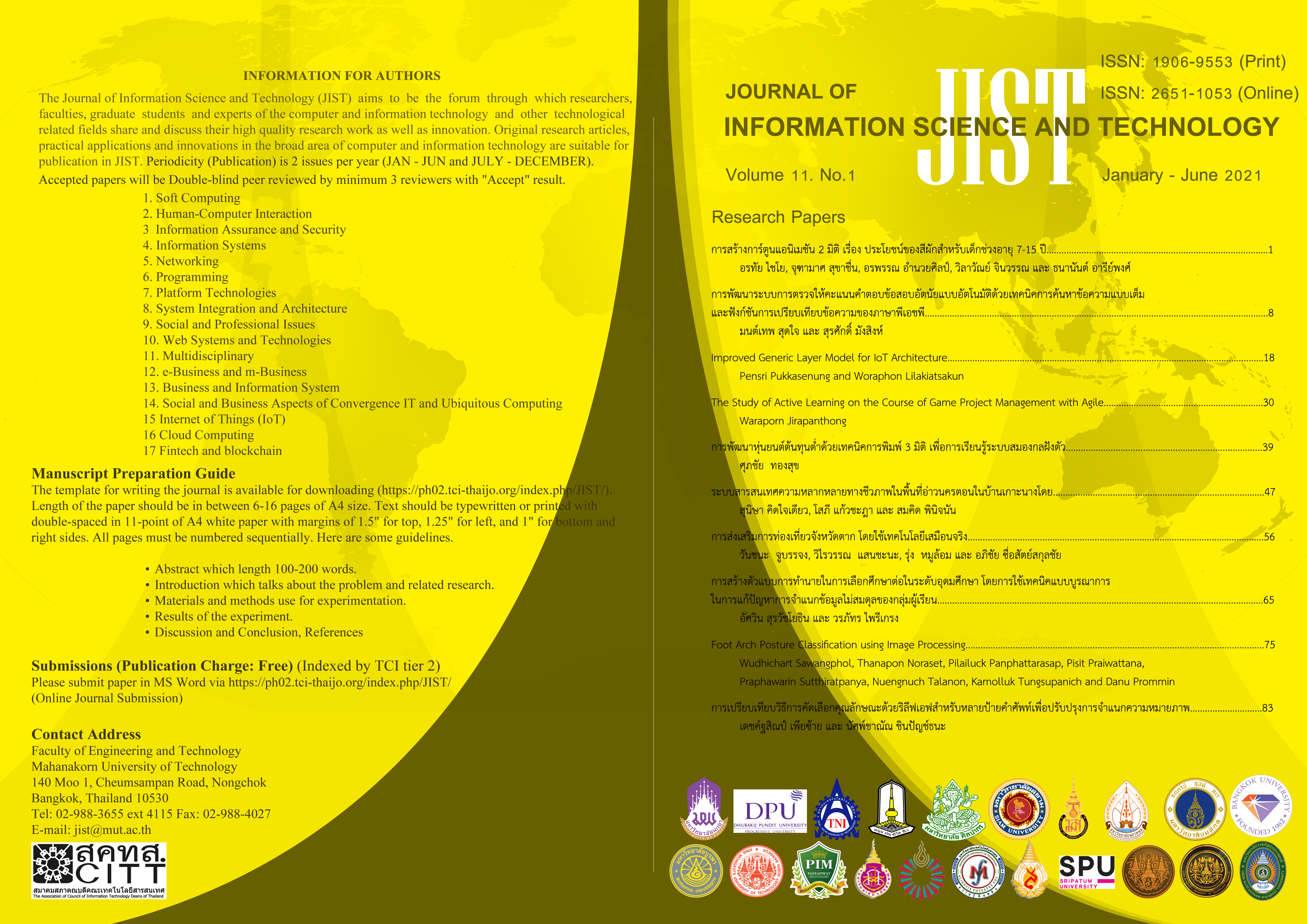The การสร้างตัวแบบการทำนายในการเลือกศึกษาต่อในระดับอุดมศึกษา โดยการใช้เทคนิคแบบบูรณาการในการแก้ปัญหาการจำแนกข้อมูลไม่สมดุลของกลุ่มผู้เรียน
Main Article Content
บทคัดย่อ
การเลือกกลุ่มสายวิชาที่ไม่เหมาะสมเพื่อเรียนต่อในระดับอุดมศึกษา เกิดจากการที่นักเรียนยังขาดประสบการณ์และยังไม่รู้จักกลุ่มสาขาวิชามากพอ ส่วนใหญ่ใช้ความรู้สึกหรือค่านิยมเป็นหลักใหญ่ในการตัดสินใจ อาจไม่ทราบถึงความรู้เฉพาะด้านของกลุ่มสายวิชาที่เหมาะสมกับทักษะของตัวเอง ดังนั้นเพื่อให้นักเรียนสามารถเลือกเรียนในกลุ่มสายวิชาที่เหมาะสมด้วยการสร้างตัวแบบการทำนายในการเลือกศึกษาต่อตามทักษะของกลุ่มผู้เรียนในเชิงพหุปัญญาโดยใช้เทคนิคแบบบูรณาการ จากการวิจัยพบว่า ข้อมูลกลุ่มสายวิชามีความไม่สมดุลกัน (Imbalanced Data) จึงแก้ปัญหาด้วยเทคนิคบูรณาการ คือ การแก้ปัญหาข้อมูลขาดหายด้วย Single Imputation การปรับสมดุลข้อมูลด้วย SMOTE การคัดเลือกคุณลักษณะด้วย RFE และสร้างตัวแบบทำนาย 3 เทคนิค คือ Bagging, Boosting, Stacking ผลการวิจัยสรุปได้ว่าทักษะที่มีความสำคัญมากที่สุดโดยการใช้เทคนิค Stacking คือ ทักษะด้านเหตุผลและคณิตศาสตร์ มีค่าความสำคัญ 77% เมื่อเปรียบเทียบกับเทคนิคอื่น ซึ่งทักษะนี้เป็นรากฐานสำคัญของวิทยาการหลายสาขาส่งผลให้ทักษะนี้มีความสำคัญในการศึกษาต่อระดับอุดมศึกษา
Article Details
This work is licensed under a Creative Commons Attribution-NonCommercial-NoDerivatives 4.0 International License.
I/we certify that I/we have participated sufficiently in the intellectual content, conception and design of this work or the analysis and interpretation of the data (when applicable), as well as the writing of the manuscript, to take public responsibility for it and have agreed to have my/our name listed as a contributor. I/we believe the manuscript represents valid work. Neither this manuscript nor one with substantially similar content under my/our authorship has been published or is being considered for publication elsewhere, except as described in the covering letter. I/we certify that all the data collected during the study is presented in this manuscript and no data from the study has been or will be published separately. I/we attest that, if requested by the editors, I/we will provide the data/information or will cooperate fully in obtaining and providing the data/information on which the manuscript is based, for examination by the editors or their assignees. Financial interests, direct or indirect, that exist or may be perceived to exist for individual contributors in connection with the content of this paper have been disclosed in the cover letter. Sources of outside support of the project are named in the cover letter.
I/We hereby transfer(s), assign(s), or otherwise convey(s) all copyright ownership, including any and all rights incidental thereto, exclusively to the Journal, in the event that such work is published by the Journal. The Journal shall own the work, including 1) copyright; 2) the right to grant permission to republish the article in whole or in part, with or without fee; 3) the right to produce preprints or reprints and translate into languages other than English for sale or free distribution; and 4) the right to republish the work in a collection of articles in any other mechanical or electronic format.
We give the rights to the corresponding author to make necessary changes as per the request of the journal, do the rest of the correspondence on our behalf and he/she will act as the guarantor for the manuscript on our behalf.
All persons who have made substantial contributions to the work reported in the manuscript, but who are not contributors, are named in the Acknowledgment and have given me/us their written permission to be named. If I/we do not include an Acknowledgment that means I/we have not received substantial contributions from non-contributors and no contributor has been omitted.
เอกสารอ้างอิง
I. Tongsamsi, "Labor Market and Educational Mismatch A Case Study of New Community Development Workers," presented at The 10th Hatyai National and International Conference, Songkla, Thailand, 2019.
S. Jantapong, "The Skills Mismatch and the Challenges to Education 4.0," MER 2018, Bangkok, Thailand, 2018.
P. Kanjanasamranwong, "THE NEEDS OF ATTENDING IN GRADUATE INSTITUTE OF GRADE 12," Journal of Education Research Faculty of Education, vol.11, no.1, pp. 75-88, 2018.
W. SAENKOSIK, "ENHANCING INTRAPERSONAL INTELLIGENCE AMONG PRIMARY SCHOOL STUDENTS USING AN INTRAPERSONAL TRAINING APPLICATION," Ph.D., RESEARCH AND STATISTICS IN COGNITIVE SCIENCE, Burapha University, Chonburi, 2018.
N. Supanatsetakul, "Interdisciplinary studies: humanities, social sciences and medicine for applying in the medical instruction," AMJAM , vol. 13, no. 3, pp. 380-392, 2013.
Office of the Higher Education Commission, "New student information," OHEC, 2020. [Online]. Available: http://www.info.mua.go.th/info/ [Accessed: Jan.12, 2021].
A. Phaeobang, "Adjusting the Imbalanced Data with 5 Classification Methods," Thai Journal of Science and Technology, vol. 9, no.4, July - August, 2020.
D. Noppamas, "Comparison of Imbalanced Data Problem Solvingfor Income Classification of Type I Pharmacies Entrepreneur," in The 9th STOU National Research Conference, pp. 1578-1586, 2018.
W. Jaidee, "The Study of Factors Affecting for On-time Graduating of Ungraduated Student Using Feature Selection Technique on Imbalanced Datasets," Journal of Information Science and Technology, vol.10, no. 1, pp. 75-84, 2020.
N. Akarachantachote, "Feature Selection for High-dimensional data in Classification," Research Methodology & Cognitive Science, vol. 8, no. 2, pp. 1-13, October 2010 – March 2011.
P. Pramokchon, "Filter-Based Feature Selection for Data Classification in IoT," FEU Academic Review, vol. 11, no. 3,pp. 98-113, 2017.
C. Songsiri, T. Rakthanmanon, and K. Waiyamai, "Applying a data mining technique to help students in selecting their majors," In Proc. The 39th Kasetsart University Annual Conference, pp. 43-50, 2001.
W. Pimpakun, "Ensemble Learning Model for Cardiotocography Classification," In Proc. Graduate Research Conference, pp. 333-340, 2012.
P. Promla, "The Comparison of Efficiency on The Analysis of Satisfaction TeachingPerformance using Sentiment Analysis by Ensemble Technique," KKU Research Journal, vol. 20, no. 4, pp. 140-149, 2020.
W. Paireekreng, "An ensemble learning based model for real estate project classification," ScienceDirect, vol. 3, pp. 3852 – 3859, 2015.
P. Thanvanon, "Predict stock price trends in Stock Exchange of Thailand usingEnsemble Model," JOURNAL OF INFORMATION SCIENCE AND TECHNOLOGY, vol. 7, no. 1, pp. 12-21, 2017.
L. Breiman, "Bagging Predictors," Machine Learning, vol. 24, pp. 123-140, 1996.
K. Nasritha, "Comparison of sampling techniques for imbalanced data classification," JOURNAL Of APPLIED INFORMATICS AND TECHNOLOGY, vol. 1, pp. 20-35, 2018.
S. Wang, "Negative correlation learning for classification ensembles," presented at the International Joint Conference on Neural Networks, IJCNN 2010, Barcelona, Spain, 2010.
C. Onsang, "Combining Multiple Models for Predicting the Risk of DiabetesUsing Multi-Kernel Learning," In Proc. NCCIT2019, pp. 1-6, 2019.
N. Sritrakul and T. Hudakorn, "The economic value and satisfaction of substituting LPG in households by a biogas network," Energy Reports, pp. 565-571, 2020.
W. Sookcharoen, "Dealing with Missing Data," ROMPHRUEK JOURNAL KRIRK UNIVERSITY, vol. 33, no. 2,pp. 11-32, 2015.



